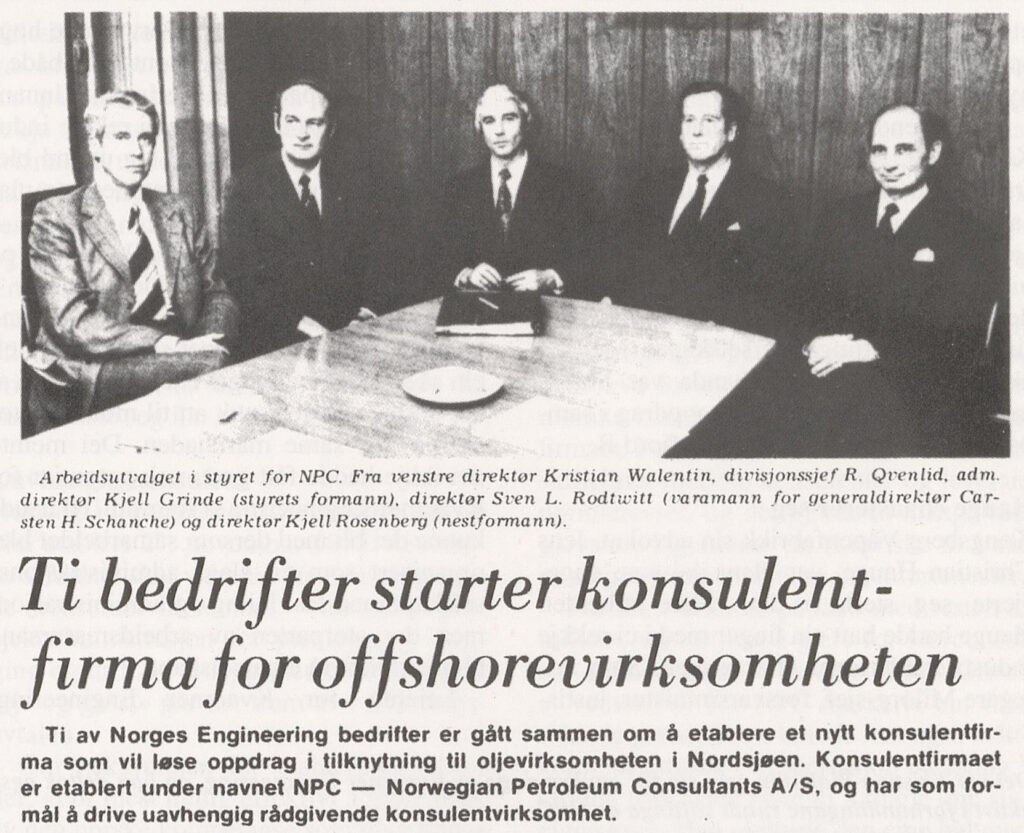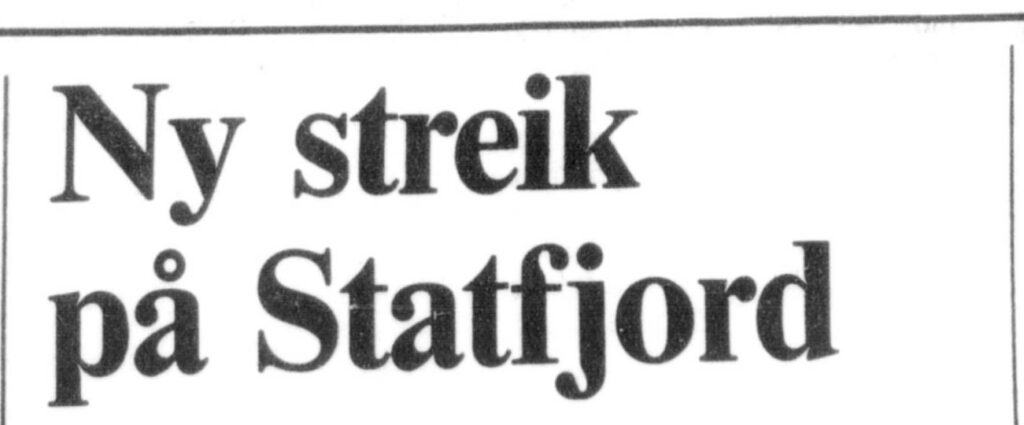Offshore employers come together

The idea of such coordination by the oil companies came from Statoil CEO Arve Johnsen, who proposed this in 1977 as a way of moderating pay growth on the Norwegian continental shelf (NCS). In his view, it was important that the industry also recognised its social responsibility and thereby helped to prevent the economy going off the rails.
Taking the initiative
Statoil had secured a sort of agreement in 1975 with the Norwegian Employers Confederation (NAF). Since none of the other oil companies in Norway were members, however, this was not a natural place for it to be at the time. Its management believed the employers could achieve more if they joined forces and, as the biggest Norwegian oil company, took the initiative to establish an organisation for NCS operators.[REMOVE]Fotnote: Board minutes, Statoil, 7 October 1977, item 11/77-2b, “Redegjørelse for virksomheten”.

At Statoil’s board meeting of 7 October 1977, Johnsen could announce that the first soundings had taken place with Norsk Hydro and Saga Petroleum as well as engineering company Norwegian Petroleum Consultants. In his view, these companies could collectively “influence developments in working conditions on the NCS so that these accorded with normal practice in the Norwegian labour market”.[REMOVE]Fotnote: Ibid. He believed it was a goal to organise “the employer side in such a way that Norwegian organisational practice, attitudes and patterns of collaboration are applied”.[REMOVE]Fotnote: Johnsen, Arve, Memorandum on organisational conditions on the NCS, board document 110/77, Statoil archive (personnel and organisation), Regional State Archives in Stavanger.
Norway’s economic downturn and the threat that offshore pay rates would also press up remuneration in other industries made it important for the oil companies to hold the line against the unions. That might be easier if they stuck together.
Another reason for the oil companies to coordinate on the employer side was the introduction of Norway’s Working Environment Act in 1977. The oil industry, and particularly the foreign operator companies, had little experience of complying with the requirements of this legislation.
Statoil, for its part, wanted to be a front runner on the working environment and would be more strongly placed to promote Norwegian values by collaborating with Norway’s other oil companies.
Spotlight on state-owned companies
For similar reasons, the Labour government commissioned a study in 1977 on coordinating the state’s employer interests in all the companies it owned. Chaired by Leif Skau, former head of the Norwegian Union of Iron and Metal Workers, this committee considered whether all of these enterprises – including Statoil – should join a state employer association.
Statoil was not interested in this, since it would limit the company’s opportunities to organise along with other oil companies and thereby reduce its influence on the NCS. All but two of the directors voted against the proposal.
More orderly conditions
The foreign workers employed on Statfjord downed tools in October 1978 in protest at poor working conditions. Statoil’s board and management became even more convinced that it, Hydro and Saga had to stand together in ensuring more orderly conditions on the NCS. In 1979, these three companies jointly established the Norwegian Operator Companies Employers Association (NOAF).
A legal strike called in July 1980 shut down the whole Norwegian North Sea for 15 days. Halting all oil and gas production on the NCS cost an estimated NOK 1.5 billion.
The oil companies found they lacked an employer organisation with more experience. NOAF’s administration was too new and unpractised to handle such labour conflicts. As a result, the three Norwegian companies asked the association to call an extraordinary general meeting of all member companies with the aim of securing NAF membership. The invitation maintained that this would give them a substantial position on the NCS. To safeguard their financial interests, the companies needed to make provision for stable working conditions and continuity in petroleum production – by implication, not interrupted by strikes:
We have furthermore noted the necessity of ensuring that the development of pay and working conditions in the oil industry is adequately coordinated with trends in other sectors/industries. In our view, only a binding collaboration between Noaf and the NAF can provide such a coordination, and we have therefore proposed that Noaf affiliates with the NAF on the same model as, for example, the Federation of Norwegian Engineering Industries (MVL).[REMOVE]Fotnote:Lange, Alexander Fossen, 2020, Den solidariske petroleumskapitalist, master’s thesis, University of Oslo: 40.
The result of this initiative was that NOAF joined the NAF on 1 January 1981, allowing its members to obtain help and guidance on relations and negotiations with the unions.
Willoch insists
Offshore workers again had great expectations ahead of the pay negotiations in the spring of 1981, but the talks broke down. The Collaboration Committee for Operator Unions (OFS), which organised workers on Statfjord as well as other fields, announced a strike. This was met by the government with compulsory arbitration, which meant that rises corresponding to the mainland settlement were awarded.

The OFS refused to accept this, and downed tools on Statfjord. Operator Mobil wanted no disruption on the field, and fairly quickly made a pay offer which the workers accepted. When the Statfjord workers secured rises close to 30 per cent, their fellow employees on Ekofisk and Frigg demanded the same. After several strikes during the autumn, the employers capitulated there as well.
The newly installed Conservative government headed by Kåre Willoch took a negative view of these stoppages and what it regarded as lunatic pay rises, and wanted to put a stop to them. There were fears they could be contagious.
Mobil, in particular, suffered a big dent in its reputation. The government forced all the oil companies to become organised on the employer side. They quite simply had to adapt to the Norwegian way of conducting labour relations. Failure to do so would have consequences for future licence awards, tax rules and the Labour Disputes Act. This became known as the Willoch doctrine.[REMOVE]Fotnote: OFS founded – Frigg (industriminne.no)
The strike wave in the North Sea thereby laid the basis for a stronger organisation of the oil companies as employers. From 1982, NOAF/NAF became parties to all collective agreements between the operator companies and unions on the NCS. That incorporated the oil sector in the organisational forms which prevailed for industries in mainland industries.[REMOVE]Fotnote: Johnsen, Arve, 1988, Gjennombrudd og vekst: Statoil-år 1978-1987: 173. Nearly 15 of the big petroleum operator companies eventually became NOAF members.
A few years later, on 1 December 1987, NOAF joined with the Norwegian Industry Association for Operator Companies (Nifo) to establish the Norwegian Oil Industry Association (OLF).
This in turn was the forerunner to today’s Norwegian Oil and Gas Association, which includes serving as an employers’ organisation among its functions.
arrow_backNorway’s most profitable inventionUnions and strikes offshorearrow_forward